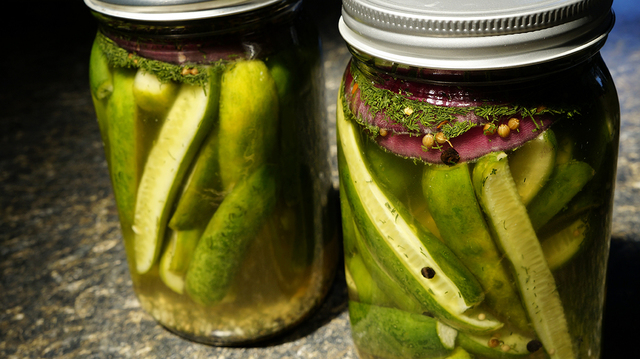Care to join me in a pickle-making project?
My family still lives in my childhood home in Portland, Ore. One of the perks of the family home is its proximity to a bountiful farmer’s market just out the back gate and across the alley.
A wonderland of fresh local produce and hand-crafted food. In this foodie fantasyland is a petite purveyor of small-batch, artisan pickles — cool, crisp, salty, dilly, briny, garlicky pickle perfection.
You can’t get this flavor from the supermarket.
My wonderful husband took pity on his Patti pining for her pickles and started experimenting with lacto-fermentation to recreate them at home. He nailed it.
I don’t have to go to PORTLAND for PICKLES! And neither do you.
Bob’s Homemade Dill Pickles
Yield: 1 quart jar Time: 10 minutes plus 3 to 7 days to ferment
Regular or pickling cucumbers
3 cloves of garlic, minced
1 1/2 teaspoons dried dill OR two sprigs of fresh dill
1/8 teaspoon red pepper flakes
1/2 teaspoon coriander seeds
1/4 teaspoon mustard seeds
1/4 teaspoon whole peppercorns
2 cups of water
1 tablespoon sea salt or 1 1/2 tablespoons kosher salt
1 quart canning jar
Optional - thick slice of onion to keep cucumbers submerged in the brine
When using regular sized cucumbers, cut them down to the size you want. With pickling cucumbers, quarter them lengthwise. I like sliced cucumbers because they ferment faster than whole ones.
Now, when you put your cucumbers in the jar, you want to pack them in tightly. Sprinkle your herbs and spices on top of them. Mix the salt and water until the salt is completely dissolved to make brine.
Pour your brine into the jar stopping about an inch below the top of the jar. It’s very important that all the cucumbers are submerged in the water and not in the air. You can add a thick slice of onion on top to hold them down, I prefer red or sweet. It also gives a nice little flavor boost to the pickles.
The best part about these pickles is that we’re using lacto-fermentation to make them. That means they’ll have probiotics (good bacteria) that are really good for your digestive system. (The store-bought kind uses vinegar to give pickles their bite.)
Set the pickle jar on the counter for three days. Watch the lid for bulging from the gases that are released during the fermentation process.
If the top of the lid is bulging up, unscrew it gently until you hear a little hissing sound, then screw it quickly back down. We don’t want the jar to burst.
After three days test your pickles for flavor, if you’re happy, pop ‘em in the fridge to stop the fermentation process, if not close the jar and test them every day until you’re happy.
Always make sure the pickles stay submerged. If there’s a white film on top of the brine, skim it off.
It’s only yeast and won’t hurt you, but will affect the taste of your pickles if you leave it.
Frugal Food contributed by Patti Diamond, author of Divas On A Dime – Where Frugal, Meets Fabulous! Facebook - DivasOnADimeDotCom www.divasonadime.com Kickstarter - http://kck.st/1Al2aLU

















